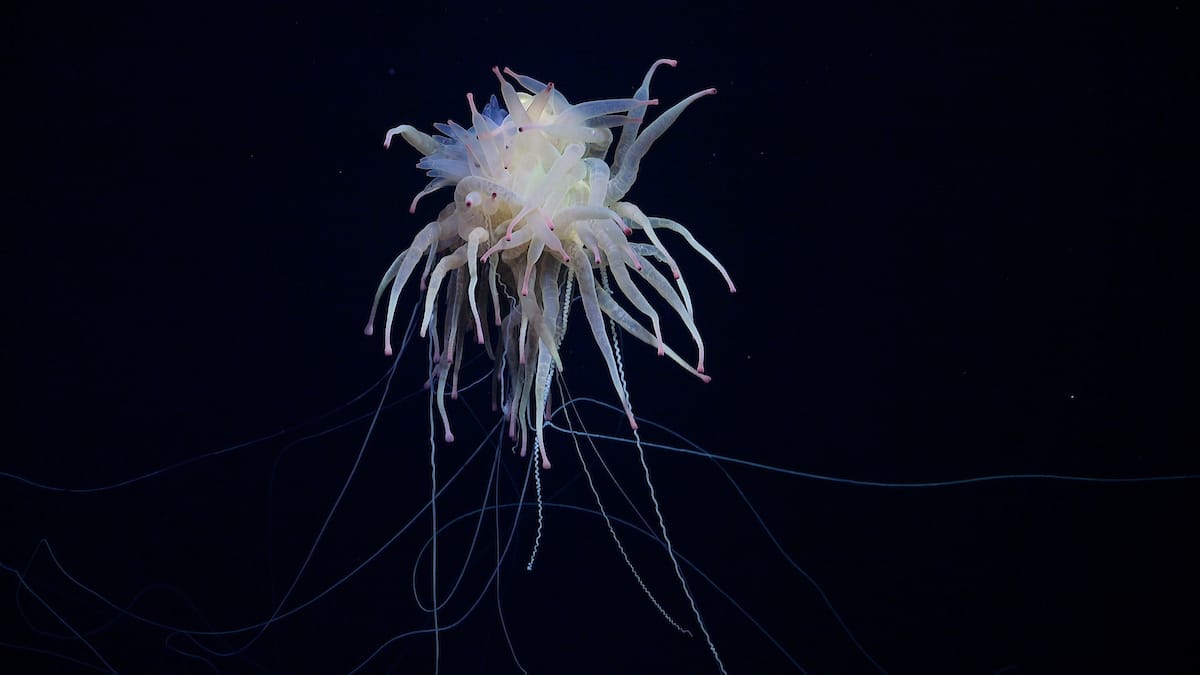The Frog Pond #22: Weird Bathypelagic Fish Roundup
At least 20 new species were found while exploring the Nazca Ridge, as well as a rare variety of cute, weird, and fin-walking fish of the sea floor.

At least 20 new species were found while exploring the Nazca Ridge, as well as a rare variety of cute, weird, and fin-walking fish.
Scientists at the Schmidt Ocean Institute (SOI) have discovered at least 20 new species while exploring seamounts on the Nazca Ridge, 900 miles off the coast of Chile1.
The seamount(or underwater mountain) in question is over 1.9 miles (3.1 km) tall compared to the surrounding sea floor. That's about four times as tall as the Burj Khalifa1. Its summit sits 994 m below the surface. Its name is under review, temporarily designated as T06.
Seamounts are typically formed from extinct volcanoes, between 1,000 - 4,000 m deep, and classified in the deep sea2.
Fun facts about seamounts:
- The summits of very large seamounts may reach up to sea level, where waves will erode their peaks into a flat surface to eventually sink below again and become "guyots"3.
- 14,500 seamounts have been identified, of which 70% have been mapped4, though few have been studied in depth (no pun intended or was it?).
- Seamounts attract a wide variety of biodiversity and are one of the most common marine ecosystems in the world5. They can be spawning grounds for larger fish, and congregation spots for marine mammals, sharks, tuna, and cephalopods6.
What did they find up/down on T06?
The SOI team found a sponge garden as well as lush coral gardens about three tennis courts in area and full of deep-sea corals1. Seamounts uniquely offer a rocky substrate to sponges, anemones, and coral while most of the seafloor is soft and covered in layers of sediment that's unsuitable for shelter and community7.
Among the creatures there, the team recorded live Promachoteuthis squid for the first time, when most of the few dead specimens on record were found in fishing nets in the late 1800s1.

Other rare but already known species found on these expeditions included the Casper octopus (pictured above, what a cutie), until now never seen in the Southern Pacific, as well as a Bathyphysa conifera, a rare siphonophore that lives in the bathypelagic zone of the ocean (between 1,000 - 4,000 m deep) and is nicknamed the flying spaghetti monster (pictured below)7. It looks more like a modern art glass chandelier than an animal.

New species found during the expedition (not yet given official classification taxonomy) include "a squat lobster" as well as various sea urchins, deep-sea starfish, anemones, corals, and shrimp8.

The expedition team also reported fossilized whale bones, which may lead to the discovery of an ancient whale species8!
The humble Sea Toad: The fish that can walk
I have to give a special section to Chaunacops coloratus, commonly known as a sea toad. It's a suborder of anglerfish! The expedition team took a photo of this amazing little guy as it braced its pectoral fins against rock and sand. Its name means "one who gapes", for obvious reasons9:

Look at its little fins!! What a round, gloomy face!! I want to ease its troubles!!
They can increase their total body volume by 30%10. Their bioluminescent dorsal fin ray hangs over their mouth11. They have small spikes all over their bodies that make them look covered in crochet12. Their modified bottom fins let them walk on the sea floor12. They're sedentary fish, mainly waiting for fish to come to them10.
This is what peak performance looks like on the sea floor.
Why do areas like T06 matter?
The seamount is so far from any coastline that the researchers found it nearly untouched by pollution, making it a rare chance at observing untouched, healthy environment in the ocean. This makes it a valuable marine site to protect for its biodiversity, geology, and geography8.
Studying locations like T06 can give us insight into the bathypelagic zone, the largest animal habitat on Earth and, until very recently, a zone that has been out of reach for exploration8.
A word from a passing frog
I got a job!! After some false starts and so. many. cover letters., I've found a great match.
Being unemployed since January has been... a journey. Watching opportunities come and go and feeling helpless to algorithms sucks! I think this job will lead to a healthy balance of stability and creativity.
I'm all ears for strategies to keep from burning out with full time work and writing!
Writing
I reached 16k in my new Dark Academia Fantasy book! Trucking along! Not much else to report, but things are going well :) I made an "inspirations" graphic for the month-long event #AllYouCanWriteAugust:

Reading
I got The Goblin Emperor back on Libby and finished the last 9% (so good!), then read:
The Inheritance Games by Jennifer Lynn Barnes: A Knives Out-style mystery featuring a surprise inheritance by a (seeming) teenage stranger to a dead billionaire's fortune.
The Bad Ones by Melissa Albert: A supernatural thriller featuring a small town, four missing people, and an infamous Goddess Game normally played in playgrounds that could tie it all together.
The Binding of Bloom Mountain by Vesper Doom: A folky, cozy fantasy featuring a recently fired park ranger's journey into the Appalachia to answer a mysterious, suspiciously high-paying ad to hike up Bloom Mountain and perform a "binding" ritual. You may see me talking about this book more this month :)
I reached my 30 book Goodreads reading goal this month!! I'm still working through Ordinary Monsters, it's a thick book!
Footnotes
2: Nybakken, James W. and Bertness, Mark D., 2008. Marine Biology: An Ecological Approach. Sixth Edition. Benjamin Cummings, San Francisco
3: IHO, 2008. Standardization of Undersea Feature Names: Guidelines Proposal form Terminology, 4th ed. International Hydrographic Organization and Intergovernmental Oceanographic Commission, Monaco.
4: https://www.sciencedirect.com/science/article/abs/pii/S0025322714000310?via%3Dihub
5: https://en.wikipedia.org/wiki/Seamount
6: https://editors.eol.org/eoearth/wiki/Seamount
9: https://etyfish.org/lophiiformes1/
10: https://onlinelibrary.wiley.com/doi/10.1111/jfb.14003
11: http://tolweb.org/Chaunacidae
12: https://www.nationalgeographic.com/animals/article/walking-fish-deep-sea-new-species-chile





